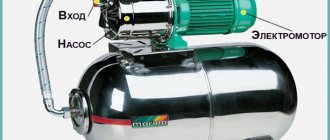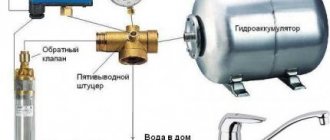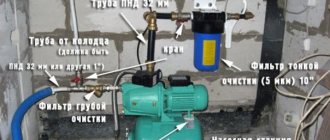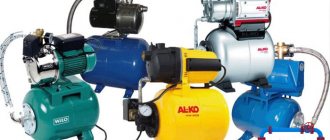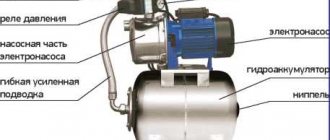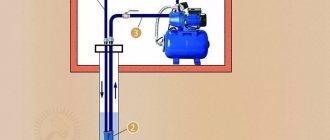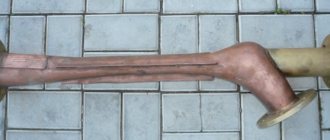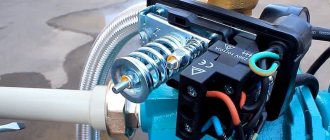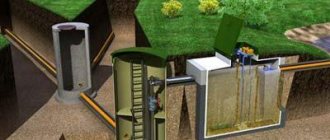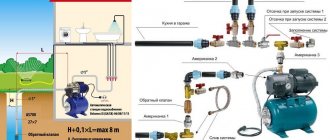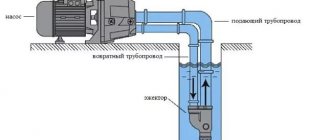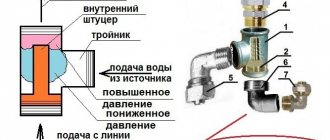Here you will learn:
- Design and principle of operation of the pumping station
- Preparing the hydraulic tank
- Setting up the pressure switch
- DIY pumping station repair
- Possible errors when debugging a pressure switch
- Features of operation of pumping stations
Adjustment of the pumping station is always carried out when assembling it independently before putting it into operation for the first time. Sometimes it is necessary to make adjustments when purchasing a factory-assembled pumping station.
Pumping station design
Factory-made pumping stations are fully equipped by the manufacturer and ready for use. Their main purpose is forced water supply. To understand how to set up a pumping station, you need to know its structure.
Such mechanisms operate according to a fairly simple scheme. Inside the accumulator there is an elastic container into which water is supplied using a pump. Filling the tank with water puts pressure on another part of the hydraulic tank filled with air or gas. When the pressure reaches the set values, the pump turns off. Taking water from the storage tank leads to a decrease in pressure in the system and when the minimum value is reached, the pump turns on again.
To turn the pump on and off, the equipment is equipped with a special pressure regulator for the pumping station. The owner can control the pressure level according to the readings of the pressure gauge, also installed on the equipment.
Operating principle of the equipment
If the hydraulic pump does not have a pressure control device, the person will have to manually adjust the operation of the station.
The principle of operation of the relay is simple and clear. A larger diameter spring presses on the plate, and it closes the contacts, after which the equipment turns on.
When the pressure in the tank reaches the set upper limit due to the action of the membrane and the smaller spring element, the mechanism is activated and the power is turned off.
As water is consumed, the pressure in the tank decreases. When the set minimum value is reached, the contacts close again and the equipment starts.
Operating principle of a pressure switch.
Main problems and causes
Various factors can damage a household pumping station, including damage to the integrity of the hydraulic tank or pipes, leakage of water or air, and the entry of various impurities into the system.
You can intervene in the operation of the pumping station in the event of problems with its operation in the following cases:
- Sand or other impurities have entered the system. This may cause corrosion and reduced performance. You can prevent clogging of the system by using various filter elements to purify water.
- Reduced air pressure in the system. This phenomenon leads to frequent operation of the pump and a decrease in its service life. Regular measurement of air pressure and setting up a pumping station if necessary helps to avoid such troubles.
- Violation of the tightness of joints in the suction pipeline. As a result, the engine is constantly running, but water is not pumped.
- Incorrect adjustment of the hydrophore causes a lot of inconvenience and can cause a malfunction of the pumping station.
Regular inspection and preventive maintenance ensure the service life of pumping equipment. It is important to remember that before adjusting the pressure at the pumping station, the pumping station must be disconnected from the power supply and the water drained.
How to change the relay range
If the “lower” pressure is normal, and you only need to increase or decrease the “upper” pressure, you need to use a smaller regulator. Wherein:
- Tightening the nut clockwise for this regulator will increase the “upper” pressure, while keeping the “lower” pressure constant.
- Unscrewing is the opposite: in this case, the difference between them - ∆P - will decrease or increase.
- After changing the adjustment, the power is turned on and the pressure gauge shows the moment when the pump turns off - the “upper” pressure.
- If the results are satisfactory, the adjustment can be stopped; if not, the process is repeated until the desired result is obtained.
Advice: It is necessary to take into account that an increase in ∆P allows the pump to turn on less often, but in this case more noticeable pressure drops will occur in the water supply network, and when it decreases, on the contrary, it will be equalized in the system, but the pump will turn on more often, which will lead to to reduce its service life.
If you are not satisfied with both the “lower” pressure and the operating range of the relay, you must first make adjustments with a large regulator, and then with a smaller one, the whole process being controlled by the station’s pressure gauge.
What is taken into account when making adjustments
When regulating the operation of equipment relays yourself, it is necessary to take into account the following important points:
- “Upper” pressure, which is more than 80% of the maximum for the product, cannot be installed on this model. As a rule, it is indicated on the packaging or in the instructions and ranges from 5 to 5.5 bar. To install a higher level in the system of a private house, it is necessary to select a relay with a higher maximum pressure.
- Before increasing the pressure to turn on the pump, you need to get acquainted with its characteristics, whether it can develop such pressure. Otherwise, if it cannot be created, the unit will not turn off, and the relay will not be able to turn it off, because the set limit cannot be reached. Pump pressure is measured in meters of water column: 1 m of water. Art. = 0.1 bar. In addition, hydraulic losses in the entire system are also taken into account.
- Do not tighten the regulator nuts completely when adjusting, otherwise the relay may stop working completely.
Troubleshooting Methods
Troubleshooting jobs can be simple or complex. In the first case, it is enough to replace the cartridges in the filter and eliminate leaks. The second option involves taking further measures if simple measures do not produce results. In this case, it is important to know how to set up the hydrophore.
More complex troubleshooting steps for pumping equipment include adjusting the pressure in the hydraulic tank and adjusting the pressure switch. In this case, you need to know what pressure should be in the water supply station.
There are several problems with the operation of a household pumping station that you can try to fix yourself.
Which pumping station unit is responsible for regulating pressure?
A standard pumping station for water supply to a house or cottage (otherwise it is also called a “reckless”) consists of several main components: a pump, an accumulator tank, a pressure gauge, a relay, and connecting elements (adapters, pipes). In addition, it can be equipped with additional options: dry-running protection, overheating protection, and a filter.
How to regulate?
The water pressure is regulated by a special relay, which is called a “pressure switch” and is necessarily included in the kit of any pumping station. With its help, the pump is turned off when its maximum set value is reached and turned on when it drops to a certain level. Most of the relays that modern household pumping stations are equipped with are a metal base on which two spring regulators are mounted: a large one with the designation “–P+” and a smaller one with the designation “-∆P+”. In addition to the regulators, there are terminals for connecting the pump, 220 V network and grounding, as well as a contact group. The whole thing is covered with a plastic lid on top. A membrane is installed at the bottom of the relay base, which is closed by a flange of a connecting pipe, usually made in the form of a quick-release connection (“American”) and with the help of which it is attached to the adapter of the pumping station.
Deviation from equipment operation requirements
Continuous operation of the equipment, without shutting down, is noted if the automation of the pumping station is configured incorrectly. In particular, we are talking about too high set pressure values. In addition, this occurs when the engine is idling, which is not accompanied by pumping water.
Such a deviation in performance may occur for the following reasons:
- The first start of the pump was carried out without filling with water. To solve the problem, you need to pour water into the pump using a special funnel and adjust the hydrophore.
- The pipeline is damaged or an air lock has formed in the suction valve. Such a problem can only be detected by checking the entire length of the pipeline for bends, narrowings or air pockets. Identified problems should be eliminated and damaged areas replaced.
- There is no access to water for operating equipment. The solution to the problem is to find the reasons for the lack of water and eliminate them.
- Blockage in the pipeline. Simply cleaning the pipeline and removing accumulated contaminants can help fix the problem.
If the station starts working and turns off after a short period of time, then the problem may be a damaged membrane. In this case, the membrane needs to be replaced. A similar situation can occur if there is no necessary pressure in the system. Here you need to take the appropriate measurements and check the hydraulic tank for cracks or other damage.
The situation with blocking the operation of the check valve occurs quite rarely. This occurs when debris or foreign objects enter the system. The situation can be corrected by disassembling the pipeline in the problem area and removing the blockage.
Operating principle of a water pump relay
A pressure regulator for connection to the pumping station provides constant pressure and the required water pressure in the system, according to the specified parameters. The device is controlled automatically. The owner must set the correct level of minimum and maximum pressure in advance, focusing on the individual characteristics of the plumbing system.
The basic operating principle of the device is as follows:
- the pump pumps water into a special tank;
- there is a gradual increase in pressure in the system (you can observe changes in parameters on the pressure gauge);
- when it reaches the maximum level set in advance, the pump automatically turns off.
The owner of a practical mechanism can use the pumped out water as needed, and the “smart” equipment will independently control the flow of liquid, replenishing water reserves when the minimum pressure level is reached. As a rule, it decreases with water consumption, and when the liquid runs out, the automatic system pumps it into the tank again.
In order for this process to be carried out in a practical manner, the owner needs to make the correct settings, according to the instructions included with the relay for the pump. Compliance with these rules will also eliminate breakdowns and significantly extend the service life.
Engine malfunction
If during the inspection the engine stops and there is no characteristic noise, then we can talk about the following:
- There is no connection to the electrical network or the voltage is too low. The solution to the problem is to check the equipment connection diagram.
- Fuse blown. In this case, the element must be replaced.
- The impeller is jammed. Difficult turning of the impeller indicates that it is jammed, so first of all you need to find out what caused this situation.
- Damaged relay. The solution to such a malfunction will be to adjust the relay or completely replace it, for which you need to know the design of the pressure switch at the pumping station.
Don’t think that engine problems can always be fixed on your own. In most cases, only specialists from the service center can solve problems.
Setting the pump on and off pressure levels
In pumping stations that are supplied assembled, the pressure switch is pre-configured according to the optimal option. But when installing it from various elements at the site of operation, it is necessary to configure the relay. This is due to the need to ensure an effective relationship between the relay settings and the tank volume and pump pressure. In addition, it may be necessary to change the initial setting of the pressure switch. The procedure should be as follows:
- After the air pressure in the tank has been adjusted, you need to connect the pumping station to the electrical network. Water will begin to be pumped in by the pump. It will turn off after reaching the set maximum pressure. This is the top level. On each device, during its manufacture, the maximum pressure and maximum permissible pump pressure are indicated; exceeding them is unacceptable. This is determined by the cessation of pressure growth. In such cases, the pump must be turned off manually. If the maximum pressure value does not coincide with the level recommended in the instructions, make the appropriate adjustment by rotating the small nut by opening the relay cover.
Insufficient water pressure in the system
Problems with water pressure can arise due to incorrect adjustment of the automation of the pumping station, but most often this occurs in the following cases:
- When configuring the system operation, values were set below the recommended minimum parameters. The problem can be solved by simply adjusting the pressure regulator of the pumping station in accordance with the instructions).
- Blockage of the pipeline or pump impeller due to accumulated contaminants. The malfunction can be eliminated by cleaning the elements of the pumping equipment.
- Air penetration into the pipeline. After checking the tightness of connections and pipeline elements, the problem almost always becomes irrelevant. In rare cases, major intervention may be required.
Sometimes you may encounter a situation where poor sealing of water pipes causes air to be drawn in by the pump. A similar situation occurs when the water level is too low, which leads to air being pumped into the system when water is drawn in.
When to adjust the relay
As mentioned above, the relay automates the process of pumping liquid into the water supply system and into the expansion tank. Most often, pumping equipment purchased ready-made already has basic relay settings. But situations arise when urgent adjustment of the pressure of the pumping station is required. You will have to perform these actions in cases where:
- after starting the pump motor, it immediately turns off;
- after the station is turned off, there is a weak pressure in the system;
- when the station is operating, an excessive compression force is created in the hydraulic tank, as evidenced by the readings of the pressure gauge, but the device does not turn off;
- The pressure switch does not work and the pump does not turn on.
Most often, if the unit exhibits the above symptoms, then relay repair is not required. You just need to configure this module correctly.
Why is a hydraulic tank needed in the system?
The membrane tank is a metal container, inside of which there is a rubber bulb for collecting water. During operation, the space between the rubber bulb and the walls of the storage tank is filled with air.
In some models of pumping equipment, the hydraulic tank consists of two compartments separated by a membrane. One compartment is filled with water, air is pumped into the other compartment.
An increase in the volume of water in the device leads to an increase in air pressure, which pushes water out of the storage tank. This operating system maintains constant water pressure even when the pump is stopped.
The hydraulic tank requires constant inspection and maintenance; in particular, it is recommended to regularly remove air from the bulb. The fact is that along with water, tiny air bubbles can get into it, which gradually accumulate inside the pear. As a result, the useful volume inside it begins to decrease. Air bubbles are removed through a special valve, which can be located in the upper part of a large hydraulic accumulator. If the container is small, then you need to disconnect the equipment from the power supply and drain the water several times and refill it again.
Determining the required pressure
Inside the drive there is a rubber container into which water is pumped, and a chamber for air. The operation of the entire system depends on the pressure in it. To check the indicators in the air compartment, first empty the tank of water.
Air is pumped into it, the pressure of which is 10% less than the lower value for the specified equipment:
- if the tank volume is 20-30 l - 1.4-1.7 atm;
- 50-100 l – 1.8-1.9 atm.
After the pressure has been determined, the rubber bulb must be filled with water, otherwise it will dry out or stick together. To increase the service life of the membrane, the pressure must be 0.1-0.2 atm below its minimum level in the water supply.
The choice of pressure affects the quality of equipment operation.
Non-standard values
Sometimes settings may not be required as recommended by the manufacturer. Often, owners increase the difference between the on and off pressure.
This allows the pump to operate less frequently, so its service life is increased. When making such a decision, you must be prepared for the fact that the pressure in the water supply will be uneven. Reducing the difference leads to a constant pressure, but the station turns on/off more often.
Upper and lower threshold
When adjusting hydraulic pumps at the factory, the average values are set:
- lower limit – 1.5-1.8 bar;
- upper level – 2.4-3 bar.
For proper operation of the system, the pressure difference must be 1.4 atm or higher.
There are some limitations when setting these parameters yourself:
- The upper threshold is set to a value not exceeding 80% of the maximum value for a given model. Most often, such characteristics are not indicated in documents. For household models this figure is 5 atm. To create higher pressure, purchase relays of higher power.
- Before making adjustments, check the characteristics of the pump. In order for it to serve for a long time, shutdown must occur when the pressure value is below the upper limit by 0.2 atm.
When making adjustments, take into account that the relay is sensitive equipment, and one turn of the nut corresponds to approximately 0.6-0.8 atm.
The factory settings of the relay need to be adjusted.
Air pressure control
At one of the stages of production of a pumping station, all its constituent elements are adjusted, including adjustment of the water pressure switch. However, after purchasing equipment in a store, it is necessary to recheck the pressure, since in most cases there is a decrease in air pressure in the interval between leaving the production line and direct sale. During operation, pressure indicators are monitored approximately twice a year. In such a situation, it is important to know how to set up automation at the pumping station.
You can measure pressure using a pressure gauge, but it is recommended to use the most accurate measuring instruments. The fact is that a deviation from the specified parameters even by 0.5 bar can negatively affect the operation of the equipment. The most reliable results can be obtained by using a car pressure gauge, which has a scale with the smallest graduation and a pressure sensor at the pumping station.
The air pressure in the membrane tank depends on the switch-on pressure values set using the relay and is 0.9 of it. In addition, in tanks with different volumes the air pressure can be 1-2 bar. The indicator is adjusted by means of a nipple through which air is pumped in or released.
A smaller amount of air in the system allows you to fill the container with water more, while the more water, the stronger the pressure. Accordingly, as water is withdrawn, the pressure will gradually decrease. If this factor is not significant for the consumer, then it is quite possible to set the lowest pressure value in the water supply station. However, the air pressure should not be less than 1 bar. Otherwise, the bulb filled with water will constantly rub against the walls of the tank, which may cause damage.
If water supply under high pressure is required, then the pressure value when adjusting the water pressure switch in the water supply system must be set within 1.5 bar. In this case, a more even and strong flow of water is ensured.
Preparing the hydraulic tank and adjusting it
Before hydraulic accumulators go on sale, air is pumped into them at the factory at a certain pressure. Air is pumped through a spool mounted on this tank.
On average, the pressure in the pumping station should be as follows: in hydraulic tanks with a volume of up to 150 liters. — 1.5 bar, in expansion tanks from 200 to 500 l. - 2 bar.
At what pressure the air is in the hydraulic tank, you can find out from the label glued to it. In the following figure, the red arrow indicates the line indicating the air pressure in the storage tank.
Also, these measurements of the compression force in the tank can be made using a car pressure gauge. The measuring device is connected to the tank spool.
To begin adjusting the compression force in the hydraulic tank, you need to prepare it:
- Disconnect the equipment from the electrical outlet.
- Open any tap installed in the system and wait until the liquid stops flowing from it. Of course, it will be better if the tap is located near the storage tank or on the same floor as it.
- Next, measure the compression force in the container using a pressure gauge and remember this value. For small volume drives, the figure should be about 1.5 bar.
To properly adjust the drive, you should take into account the rule: the pressure that triggers the relay to turn on the unit must exceed the compression force in the drive by 10%. For example, a pump relay turns on the motor at 1.6 bar. This means that it is necessary to create an appropriate air compression force in the storage tank, namely 1.4-1.5 bar. By the way, the coincidence with the factory settings is not accidental.
If the sensor is configured to start the station engine at a compression force greater than 1.6 bar, then, accordingly, the drive settings change. You can increase the pressure in the latter, that is, pump up the air, if you use a pump to inflate car tires.
Advice! It is recommended to correct the air compression force in the accumulator at least once a year, since during the winter it can decrease by several tenths of a bar.
Relay operating principle
The main element of the pressure switch can be called a group of contacts mounted on a metal base. It is this part that turns the device on and off. A large and small spring is located next to the contacts; they regulate the pressure inside the system and help in deciding how to increase the water pressure in the pumping station. A membrane cover is attached to the lower part of the metal base; under it you can directly see the membrane and the metal piston. The entire structure is covered by a plastic cap.
To understand how to properly set up a pumping station, you need to know that the pressure switch works according to the following scheme:
- When you open the tap, water from the storage tank flows to the collection point. In the process of emptying the container, the pressure begins to gradually decrease, and accordingly, the degree of pressure of the membrane on the piston decreases. The contacts close and the pump starts working.
- While the pump is operating, the taps at the dispensing points can be open, at which time water is supplied to the consumer. When the tap is closed, the hydraulic tank begins to fill with water.
- An increase in the water level in the tank leads to increased pressure in the system, which begins to put pressure on the membrane. It begins to put pressure on the piston, which opens the contacts and stops the pump.
A properly adjusted water pump pressure regulator ensures normal frequency of switching on and off of the pumping station, normal water pressure and equipment service life. Incorrectly set parameters cause continuous operation of the pump or its complete stop.
Setting up the pressure switch
There are cases when the default sensor settings do not suit users of pumping equipment. For example, if you open a tap on any floor of a building, you will notice that the water pressure in it quickly decreases. Also, the installation of some water purification systems is not possible if the compression force in the system is less than 2.5 bar. If the station is configured to turn on at 1.6-1.8 bar, then the filters will not work in this case.
Typically, setting up a pressure switch with your own hands is not difficult and is performed according to the following algorithm.
- Record the pressure gauge readings when turning the unit on and off.
- Unplug the station's power cord from the outlet or turn off the circuit breakers.
- Remove the cover from the sensor. It is usually secured with 1 screw. Under the cover you can see 2 screws with springs. The larger one is responsible for the pressure at which the station engine starts. Usually next to it there is a marking in the form of the letter “P” and arrows are drawn with “+” and “-” signs next to them.
- To increase the compression force, rotate the nut towards the “+” sign. And vice versa, to reduce it, you need to turn the screw towards the “-” sign. Make one turn of the nut in the required direction and start the machine.
- Wait until the station turns off. If the pressure gauge readings do not suit you, then continue to rotate the nut and turn on the device until the pressure in the accumulator reaches the required value.
- The next step is to set the moment to turn off the station. A smaller screw with a spring around it is designed for this. Near it there is a marking “ΔP”, and also arrows with “+” and “-” signs. Setting the pressure regulator to turn on the device is carried out in the same way as to turn off the device.
On average, the interval between the compression force at which the sensor turns on the station engine and the compression force value when the unit stops is within 1-1.5 bar. In this case, the interval may increase if the shutdown occurs at large values.
For example, the unit has factory settings at which Ron = 1.6 bar and Roff = 2.6 bar. It follows from this that the difference does not go beyond the standard value and is equal to 1 bar. If for some reason it is necessary to increase Roff to 4 bar, then the interval should be increased to 1.5 bar. That is, Rvkl should be about 2.5 bar.
But as this interval increases, the pressure drop in the water supply system will also increase. Sometimes this can cause discomfort, since you will have to use more water from the tank for the station to turn on. But thanks to the large interval between Ron and Roff, the pump will be turned on less frequently, which will increase its resource.
The above-described manipulations with the compression force settings are possible only with equipment of the appropriate power. For example, in those The passport for the device states that it can produce no more than 3.5 bar. This means that setting Roff = 4 bar on it does not make sense, since the station will work without stopping, and the pressure in the tank will never be able to rise to the required value. Therefore, in order to obtain a pressure in the receiver of 4 bar or higher, it is necessary to purchase a pump of appropriate power.
How to properly adjust the relay and calculate pressure
All devices leave the production line with certain settings, but additional testing must be performed after purchase. When purchasing, you need to find out from the seller what values the manufacturer recommends using when adjusting the depth pressure. In other words, the pressure at which contacts close and open.
If the station fails due to improper adjustment of the pressure switch of the jumbo pumping station, then it will be impossible to take advantage of the manufacturer's warranty.
When calculating the pressure parameters for turning the device on and off, the manufacturer takes into account the expected operating conditions. When developing the operating parameters of various pump models, operating conditions are also taken into account.
Device and principle of operation
To understand the relay design, you need to clearly understand its function. In most cases, this device acts as a switch that connects and disconnects the electrical circuit of the pump. For this purpose, the relay has two synchronously operating pairs of contacts - a contact group.
It is attached to a flat spring on a hinge, which snaps the contacts between the “closed” and “open” positions. There is a terminal block for connecting the network cable and the wire leading to the pump.
All actions of this device depend only on the water pressure in the pipeline to which it should be connected. To do this, a tee is cut into the pipe, the outlet of which has a thread. The relay is screwed onto it, in the lower part of which there is a pipe for this purpose.
Pressure switch for pumping station AL-KO HWF 1300
The most convenient way to connect a relay is to use not a tee, but a special manifold with three outlets, to which, in addition to the relay, a hydraulic accumulator and a pressure gauge are connected. The connecting pipe of the relay has a movable membrane that senses water pressure. By means of a rod it is connected to the contact group platform, which is also movable.
The relay's job is to maintain water pressure within a certain range. As soon as it drops to a certain minimum value (switching pressure P1), the electrical circuit of the pump will be closed and it will begin to supply water. When it reaches the upper limit of the range (cut-out pressure P2), the circuit will be open. The specific values of P1 and P2, that is, the relay settings, depend on the compression force of two springs, which we will call large and small. Each of them is put on a stud with a nut.
Let's take a closer look at the relay operating cycle:
- The water pressure in the pipe through the membrane and the rod tends to move the platform of the contact group upward. It is counteracted by a large spring installed directly opposite the membrane. When it gets low, the spring overpowers it, forcing the platform down. When it occupies the lowest position, the contacts close with a characteristic click.
- The growing pressure compresses the large spring, forcing the platform with the contacts to move upward. Having risen to a certain height, the other side rests against a small spring installed a little further. Now the pressure has to overcome the opposition of two springs. As soon as he manages to do this, the platform will take the highest position and the contacts will open - the pump will stop working.
- As water is consumed, the pressure drops again and the described cycle repeats from the beginning.
There are so-called low-current relays that cannot be included in the power circuit. They control the operation of the pump indirectly - through a magnetic starter or other switch.
In addition to the main ones, the device may have additional elements, for example, a dry-running protection mechanism.
In order for water to be supplied from the source with the required pressure, the relay must be configured correctly. Adjusting the pressure switch of the pumping station is a key stage in setting up an autonomous water supply system.
To optimize the operation of the water supply pump, hydraulic tanks are used as water storage tanks. What are the advantages of using hydraulic accumulators and how to choose the right unit, read here.
Constant good water pressure in the absence of a centralized water supply is not an easy task. Even with a good pump, an autonomous system has its drawbacks. Hydraulic tanks are used to optimize the system. Here https://aquacomm.ru/vodosnabzenie/zagorodnyie-doma-v/nakopitelnyj-bak-dlya-vodosnabzheniya.html you will learn what the drive is needed for and how to install it correctly.
How to set recommended settings
Before setting up a water supply station, you need to measure and record the current values, for which you need to use a pressure gauge. Turn on the pump and record the pressure readings when it is turned on and off. Based on the results, they determine whether to increase or decrease the values when deciding how to adjust the deep-well pump.
The pressure setting of the pumping station is carried out as follows:
- Disconnect the pump from the power supply, drain the water and use a wrench to remove the relay cover.
- To adjust the activation pressure, you need to rotate the nut holding the large spring. When twisting it clockwise, the spring begins to compress and the required switching pressure is established. Various models can have an operating pressure of the pumping station in the range of 1.1-2.2 bar.
- By rotating the small spring nut clockwise, you can increase the difference between the cut-in and cut-out pressures. In most cases, this gap is equivalent to 1 bar. You need to know this before increasing the pressure in the pumping station. As a result, the shutdown pressure is fixed at a value in the range of 2.2-3.3 bar.
It is very important to understand that you cannot set the shutdown threshold by adjusting the small spring. Although many home craftsmen insist on this version. Using a small spring, the difference between the switch-on pressure value and the station switch-off pressure value is established. With the spring completely relaxed, the difference will be zero and the on and off values will be equal. As the spring is tightened, the delta between values gradually increases.
To check whether the water pressure switch has been adjusted correctly with your own hands, you need to measure the pressure using a pressure gauge. If after checking the recommended values are not obtained, then adjustment should be continued.
Situations requiring relay adjustment
When operating a hydraulic pump, various situations arise that result in malfunctions in its operation. The reason for the incorrect operation of the equipment is the incorrect mode of turning it on/off.
New equipment
If both springs are not adjusted in the new equipment, then the relay is adjusted in the following sequence:
- Turn off the hydraulic pump. Open the tap located at the maximum distance from the station. If the water pressure is satisfactory, then record the pressure gauge readings and turn off the device.
- Disconnect from the network, turn the nut on the large spring until the contacts close.
- The pump is started again, it should work until the pressure gauge is 1.4 atm higher than the previously recorded mark.
- Turn off the pump and disconnect it from the electricity. Carry out the adjustment. To do this, twist the nut located on the smaller spring until a click appears, indicating that the contacts have opened.
Constant spontaneous turning on and off
This is due to the fact that there is a rapid increase in pressure, and the motor turns off, but it also drops quickly, and it turns on again. The problem is not with the relay, but with a stretched or torn rubber plate on the drive. To fix the problem, you need to disassemble the tank and change the membrane.
The principle of operation of the membrane in a hydraulic accumulator.
The station does not turn off
Most often this is due to wear on the pump parts, so it cannot create the required pressure. To eliminate such a breakdown, it is enough to reduce the maximum indicator. If the parameters have to be reduced to critical values, then the pump will need to be replaced.
The pump does not turn on
There are several reasons why the hydraulic pump does not turn on:
- terminal oxidation;
- electrical wiring faults;
- failure of the electric motor.
To find the cause, a tester is used to check the electrical circuit.
When a relay needs to be changed and not adjusted
It is not always possible to repair a relay; there are situations when it simply needs to be replaced. When working properly, it protects the electric motor from overloads and the membrane from damage.
Replacement is performed in this order:
- Disconnect the pump from the network, empty the water tank, and open the taps.
- Disconnect the pump connection cable and remove it from the pipe.
- Remove the old relay. It is attached to the pipe through a fitting. There is residual pressure in the system, so you need to prepare a bowl to collect the remaining water.
- Install a new relay and tighten the fitting tightly. You need to use a new gasket to avoid leaks. The condition of the springs is checked; in most cases, they are adjusted at production.
- Connect the wires.
- Close the taps and start the pump. If the manufacturer’s settings are not satisfactory, they are adjusted according to the previously described algorithm.
Installing a new relay.
Setting non-standard parameters
The pressure in the devices may differ from the manufacturer's recommendations. This situation arises when it is necessary to configure the equipment to the individual characteristics of the system, depending on the pressure in the water supply station.
If you increase the difference between the on and off pressure values, the relay will operate much less frequently. This allows you to extend the life of the pumping station, but the water pressure will be inconsistent.
If water supply under high pressure is required, then the delta pressure values must be reduced. This will cause the pump to turn on more often.
When independently deciding how to adjust the pumping station, you must remember that deviations from the values recommended by the manufacturer can negatively affect the operation of the water supply system. The fact is that all components of the pumping station operate at certain pressure values, violation of which can cause equipment failure. Therefore, before you set up the automation on the pump yourself, you need to get advice from an experienced specialist.
Initial setup
If the springs on your relay are completely weakened, you will have to make the adjustment from scratch. In this case, the work is carried out in the following sequence:
- They start the pumping equipment and build up pressure in the system to a level where the water pressure from the tap farthest from the pump becomes more or less acceptable to you. Let's assume that the measuring device showed a value of 1.5 bar at this moment. We turn off the pump.
- Now you need to disconnect the pumping station from the power supply, open the cover on the relay and start tightening the nut on the large spring until a characteristic click is heard, indicating the contacts are closed.
- The relay cover is installed in place and the pumping equipment is started. In this case, the pressure must be increased to 2.9 bar.
- Now the unit needs to be disconnected from the power supply again, open the cover on the relay again and tighten the nut of the small spring until a click sounds when the contacts open.
- After the settings have been made, the relay will operate at a lower pressure of 1.5 bar and turn off the pump at an upper pressure of 2.9 bar. We return the cover on the relay to its place, and connect the station to the power supply.
Setting up the mechanism
When assembling a pumping station, you need to pay special attention to the settings. If the user makes a mistake and enters incorrect parameters, the automatic system may malfunction during operation.
After purchase, the water pressure switch for pumps is checked by measuring the pressure set during the manufacture of the device. For this purpose, we recommend using a regular car pressure gauge. To determine the exact level, it is necessary to use a device with a graduated scale, of a mechanical type.
Some devices are equipped with a plastic pressure gauge, however, as practice shows, this device does not give accurate readings when measuring. Electronic devices are quite convenient, but when the battery charge is low, as well as in the case of atypical temperature changes, they can also give incorrect parameters. To avoid making mistakes, choose a regular mechanical pressure gauge! With its help, you will be able to quickly measure and configure the pressure switch for practical functionality of pumping equipment.
After taking measurements, we proceed to setting up the relay:
- remove the cover, under it there are two nuts of different sizes;
- turn the large nut to adjust the lower parameter in the hydraulic accumulator;
- using a small nut, the pressure difference is set;
- the position of the large spring is the reference point giving a reference point for setting the lower pressure limit.
Next, we monitor the level of air pressure in the accumulator. When it reaches the required parameters, we connect the tank to the general system and start the pumping station, observing the pressure gauge readings.
When the measuring device records the required value, the pump should be turned off. The further setup stage involves the following actions:
- Carefully rotate the small nut until the mechanism starts.
- The water opens to completely empty the system.
- Next, you need to wait for the relay to turn on, which means reaching the optimal values set at the lower indicator.
- We proceed to setting the lower pressure limit, using a large nut for this purpose.
- We turn on the pump and wait for the pressure in the system to increase to the maximum level.
- The final stage is adjusting the small nut.
The configured unit will practically pump water into the tank, creating the best operating conditions for users of water equipment. However, even after correctly setting the necessary parameters, do not forget to periodically check the working system and adjust it, if necessary.
How to customize a pressure switch for individual needs
Individual configuration or reconfiguration of relay operation after a failure is carried out as follows:
- At the very beginning, you need to open the relay housing by disconnecting the protective casing from the base. After all, it is under the casing that the electric motor contacts and relay adjustment units are “hidden”: a pin with a large nut holding a large spring and a pin with a small nut holding a small spring. In this case, the tension of the large spring regulates the minimum pressure, and the tension of the small spring regulates the pressure difference.
- The adjustment of the “starting” (minimum) pressure begins on an empty storage tank. Moreover, to free the accumulator from liquid, you just need to turn off the pump and open the tap. The adjustment itself is carried out as follows: the large spring is loosened completely (the nut is unscrewed counterclockwise), then you should turn on the pump and begin to gradually tighten the spring. At the moment when the pump starts working and starts pumping water, stop manipulating the large nut - the minimum pressure has reached the pressure mark in the air part of the accumulator plus 0.2-0.3 atmospheres. And if there is 1.2-1.3 atmospheres behind the battery membrane, then the minimum pressure in the tank will approach the desired 1.5 atmospheres. Well, whoever wants more must, at the beginning of the adjustment, “add” the pressure in the accumulator (by pumping air behind the membrane).
- Adjusting the pressure difference is even easier. You just need to wait for the pump to stop and read the reading from the pressure gauge on the accumulator manifold. If the result is not satisfactory, the pump is turned off, the water is drained, and a small nut is screwed in (to increase the pressure) or unscrewed (to decrease the pressure) onto a stud with a small spring. After this, the pump is turned on and the “new” upper pressure obtained after adjustment is read.
A few simple tools and techniques for setting relay parameters
Adjustment of the water pressure switch for the pumping system is carried out by rotating the required parameters set by the corresponding nuts “P” and “?P”.
It is the first among all elements of the system that is responsible for adjusting the cut-off pressure parameters, or, in other words, sets the upper limit of values. The second, or as it is commonly called “delta,” controls the parameter of the difference between two types of pressure – on and off. In other words, with the last nut you can set the required lower limit that is relevant for the pumping station, or you can regulate the pressure level of the current switching mechanism.
Types of pressure regulators
Before buying a regulator for a water pump, we recommend that you decide on the type of optimal equipment, focusing on your personal needs and budget.
The most accessible and inexpensive units are of the mechanical type. The second option, an electronic pressure switch, has many advantages:
- the user can set the necessary parameters as accurately as possible, choosing the optimal pressure range for turning the device on and off;
- thanks to the built-in flow controller, the electronic device instantly turns off when the intake of liquid into the tank stops;
- has a long service life, characterized by the protective functions of the device.
Mechanical devices are more demanding; they must be regularly disassembled to tighten weakened springs. The electronic relay does not require such disassembly, which significantly improves operating conditions, eliminating the need for such work.
The user can quickly install the electronic relay without using special tools for this purpose. The instructions included with the device will allow even an inexperienced owner of new equipment to securely attach the device to the water pump.
The cost of an electronic relay is slightly more expensive than mechanical models, but the price fully corresponds to the quality. The choice is yours!
For a pumping station, a pressing issue during current operation will be the adjustment of the water pressure switch for the pump, which can be done independently. How to do this and how labor-intensive it is - read the article.
Is it possible or not to adjust the relay?
The function of the unit is intended directly to automate the workflow of installed equipment, turning off or on the pumping device.
In the case where the pump was purchased directly from the factory, the device was most likely sent to the buyer assembled. In this case, it already has standard parameters installed and nothing else needs to be adjusted. This is a cut-out pressure setting of 2.5 (3), while the cut-in pressure is set to 1.5 (1.8) by default. Pressure is measured in atmospheres or bars, standard values for such equipment. It is by adjusting these values that you can easily fine-tune the operating parameters of the system, depending on the required operating conditions.
Self-adjustment of pressure parameters is only possible if the water pressure switch for the pumping station is supplied disassembled, and the station is assembled independently from special elements and assemblies.
In this case, the relay performance must be regulated, since it directly depends on a number of key features during operation. There is a direct relationship between the specific parameters of the volume of the hydraulic accumulator, the pump pressure data, as well as the correctly executed settings of the operating relay.
